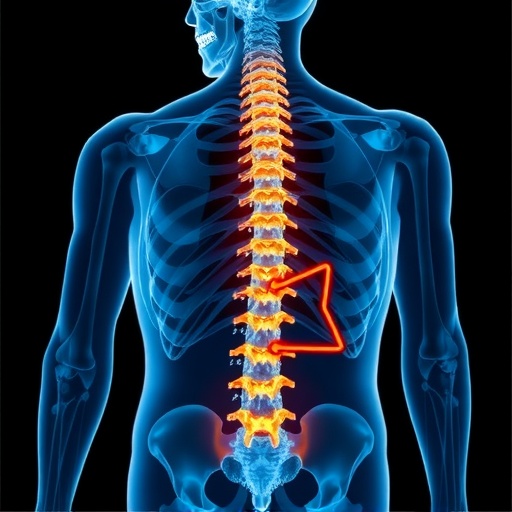PROTECT YOUR DNA WITH QUANTUM TECHNOLOGY
Orgo-Life the new way to the future Advertising by AdpathwayIn a groundbreaking advancement poised to redefine adolescent cardiovascular health screening, a recent study has introduced and validated a continuous metabolic syndrome risk score (msRS) tailored specifically for adolescents. This innovative metric, derived through rigorous confirmatory factor analysis, offers a nuanced and dynamic approach to quantifying the risk of metabolic syndrome (MetS) in young populations, a demographic often overlooked in traditional risk assessments. The research not only bridges a vital gap in adolescent health monitoring but also provides a powerful clinical tool to elucidate the complex interplay between metabolic factors and cardiovascular risk profiles during this critical developmental period.
Metabolic syndrome, a cluster of conditions including abdominal obesity, insulin resistance, dyslipidemia, and hypertension, is a known precursor to cardiovascular disease and type 2 diabetes. While extensive studies have focused on adult populations, adolescents’ unique physiological and developmental traits pose significant challenges to creating consistent and predictive risk scores in this group. The novel msRS circumvents these obstacles by integrating multiple metabolic and clinical parameters into a singular continuous variable. This advancement allows for a more precise stratification of risk, moving beyond the binary or categorical diagnostics that have traditionally dominated pediatric metabolic evaluations.
The research team’s methodology centered on confirmatory factor analysis (CFA), a sophisticated statistical technique that tests whether data fits a hypothesized measurement model. By applying CFA, the researchers were able to identify latent variables that encapsulate the underlying structure of metabolic syndrome in adolescents. This process yielded a continuous risk score that reflects the degree of metabolic disturbance rather than merely the presence or absence of specific criteria. Importantly, this approach accounts for the heterogeneity inherent in adolescent physiology, where transient changes in metabolism and growth could otherwise confound risk assessment.
To establish the robustness and clinical utility of the msRS, the investigation utilized two distinct adolescent cohorts, reflecting diverse population characteristics and health profiles. This dual-population strategy ensured that the risk score possesses strong generalizability across various demographic and ethnic backgrounds. Stratification by traditional cardiovascular markers allowed the research team to closely correlate msRS values with established clinical indicators, thereby reinforcing the score’s predictive validity. Such a comprehensive validation framework enhances confidence in msRS as a reliable metric for early cardiovascular risk detection.
One of the most striking features of the msRS is its continuous nature, which contrasts sharply with existing MetS diagnosis schemes reliant on fixed cutoffs. This continuous spectrum facilitates the identification of subtle but clinically meaningful shifts in metabolic health, potentially enabling earlier intervention and personalized therapeutic strategies. For adolescents, in whom physiological parameters evolve rapidly, this granularity is crucial. The msRS may therefore serve as a pivotal surveillance tool, guiding clinicians in monitoring metabolic health trajectories over time rather than relying on static snapshots.
Cardiovascular clinical markers (CCMs), including measures such as carotid intima-media thickness, blood pressure variability, and endothelial function, were key endpoints in the study’s evaluative framework. By demonstrating a strong association between the msRS and multiple CCMs, the researchers have highlighted the score’s relevance not only in metabolic categorization but also in reflecting tangible cardiovascular implications. This integrative perspective underscores the interconnectedness of metabolic and vascular health during adolescence, a period when early vascular changes can set the trajectory for future morbidity.
The utility of the msRS also extends to its potential role in public health initiatives targeting youth populations. Given the rising prevalence of pediatric obesity and type 2 diabetes worldwide, tools like the msRS could facilitate large-scale screening and risk stratification, prioritizing high-risk individuals for preventive interventions. Moreover, the score’s sensitivity to incremental metabolic disturbances makes it an ideal candidate for monitoring responses to lifestyle modifications and pharmacologic treatments, enhancing the precision of adolescent care.
Importantly, the msRS was developed with an eye toward practicality and clinical applicability. The components incorporated into the risk score are derived from widely accessible clinical tests, ensuring that the tool can be feasibly integrated into existing pediatric healthcare workflows. This practicality stands to accelerate adoption in various healthcare settings, from primary care offices to specialized adolescent clinics, making metabolic risk assessment a routine aspect of adolescent health maintenance.
The research also touches upon the potential for msRS to facilitate personalized medicine approaches. By enabling continuous risk monitoring, the score allows for individualized intervention thresholds, moving beyond the “one-size-fits-all” approach that often dominates clinical guidelines. As adolescent metabolic risk factors fluctuate with puberty, lifestyle, and environmental influences, the msRS could provide real-time feedback to clinicians and patients, fostering a dynamic and participatory management paradigm.
Further, the study’s reliance on dual adolescent populations for validation strengthens the external validity and adaptability of the msRS. Diverse ethnic, socioeconomic, and geographical backgrounds are critical variables influencing metabolic syndrome prevalence and expression. By demonstrating consistent performance across these variables, the score emerges as a universally applicable tool with broad relevance amidst the global adolescent population.
In light of the mounting evidence linking early-life metabolic disturbances with lifelong cardiovascular disease risk, the msRS represents a critical step forward in preemptive healthcare. Through its nuanced and statistically grounded design, the score offers a window into the subclinical processes underpinning youth metabolic dysfunction, affording clinicians the opportunity to implement interventions before irreversible organ damage occurs.
The study’s authors also discuss the limitations inherent in previous MetS assessments, particularly their categorical definitions that often overlook subthreshold risk markers. By adopting a continuous framework, the msRS challenges existing diagnostic conventions, aligning risk evaluation more closely with the biological continuum of disease progression. This philosophical and methodological shift could inspire future revisions of metabolic and cardiovascular risk assessment standards, particularly for pediatric populations.
Statistical robustness was emphasized throughout the research process. The confirmatory factor analysis not only ensured that the msRS reflects underlying biological constructs but also provided a mechanism for ongoing refinement as additional data emerge. This adaptability means that the msRS can evolve alongside advances in metabolomics and cardiovascular diagnostics, maintaining its relevance in an ever-changing clinical landscape.
The clinical implications of this research are profound. By equipping clinicians with a reliable and sensitive tool for adolescent metabolic risk stratification, the msRS supports earlier identification of high-risk individuals. This could precipitate a cascade of earlier lifestyle counseling, targeted pharmacotherapy, and enhanced monitoring, ultimately reducing the burden of adult cardiovascular disease that has its roots in adolescent health.
Finally, the integration of msRS into clinical practice carries potential to improve health equity. Metabolic syndrome disproportionately affects socioeconomically disadvantaged youth, who often face barriers to comprehensive healthcare. A standardized, accessible risk score like msRS could aid in mitigating these disparities by informing community-level screening programs and resource allocation to vulnerable populations.
This study’s introduction of a confirmatory-factor-analysis-derived metabolic syndrome risk score signifies a paradigm shift in adolescent metabolic health assessment. Its validation across diverse populations and correlation with multiple clinical cardiovascular markers heralds a new era of precision medicine tailored to the dynamic physiology of youth. As the global adolescent population faces escalating metabolic and cardiovascular challenges, tools like the msRS offer hope for timely, accurate risk detection and personalized intervention—cornerstones in the battle against the silent epidemic of adolescent metabolic syndrome.
Subject of Research: Development, validation, and clinical application of a continuous metabolic syndrome risk score for adolescents
Article Title: Confirmatory-factor-analysis-derived metabolic syndrome risk score: development, validation, and clinical utility in dual adolescent populations
Article References:
Chin, YT., Wu, PW., Huang, PR. et al. Confirmatory-factor-analysis-derived metabolic syndrome risk score: development, validation, and clinical utility in dual adolescent populations. Pediatr Res (2025). https://doi.org/10.1038/s41390-025-04419-w
Image Credits: AI Generated
DOI: https://doi.org/10.1038/s41390-025-04419-w
Tags: adolescent health monitoring toolsadolescent metabolic syndrome risk scorecardiovascular health screening for teensclinical tools for monitoring metabolic syndrome in teensconfirmatory factor analysis in adolescentscontinuous metabolic syndrome score for youthinnovative metrics for metabolic syndromeintegration of metabolic factors in youth healthmetabolic syndrome and cardiovascular disease preventionpediatric cardiovascular risk assessmentrisk stratification in adolescent healthunique challenges in teen metabolic assessments


 5 hours ago
5
5 hours ago
5





















 English (US) ·
English (US) ·  French (CA) ·
French (CA) ·